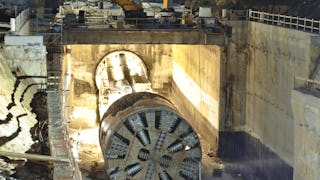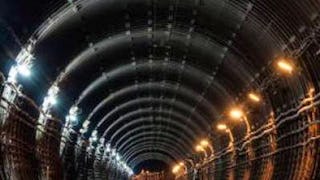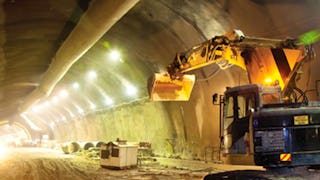The course on "Deep Excavations and Support Systems" offers a comprehensive journey through the intricacies of underground construction and soil retention. Beginning with an exploration of tunnels, caverns, and shafts, the course covers diverse applications and construction methods, emphasizing stress distribution complexities and the pivotal role of site investigation. It then delves into Pre-Excavation Support Systems, dissecting rock mass classification, excavation methods, and various support techniques like Ground Freezing and Face Grouting. The Retaining Systems module follows, providing insights into structures for soil stabilization, including Contiguous Pile, Secant Pile, Soldier Pile, Sheet Pile, and D-Wall. The final module, "Concepts and Tools in Embedded Retaining Systems," addresses design parameters, lateral earth pressures, and numerical modeling, integrating practical applications and relevant codes. This comprehensive course equips learners with the knowledge and skills needed for efficient, safe, and successful deep excavation projects. This course is majorly for consumption in the Indian subcontinent and the target audience are undergraduate and post graduate students, faculties and freshers who has entered the industry as young professionals.


Deep Excavations and Support Systems
This course is part of Construction Practices in Deep excavations and Tunnels Specialization

Instructor: Subject Matter Expert
Included with
Recommended experience
What you'll learn
Types of Pre- Excavation support systems – Rock Anchors, Umbrella Arch method, Pre-Grouting, Freezing
Diaphram walls, Secant pile walls, Contigious pile walls, Soldier piles,Diaphrgam walls
Significance of Pre Excavation Support systems and Overveiw of Plaxis 2D,Wallap, RocLab and RS2
Skills you'll gain
- Engineering Design Process
- Mathematical Software
- Structural Engineering
- Engineering Practices
- Engineering Calculations
- Construction
- Engineering Analysis
- Building Codes
- Construction Engineering
- Simulation and Simulation Software
- Engineering, Scientific, and Technical Instruments
- Civil Engineering
- Structural Analysis
- Finite Element Methods
- Laboratory Testing
- Environmental Engineering
Details to know

Add to your LinkedIn profile
4 assignments
See how employees at top companies are mastering in-demand skills

Build your subject-matter expertise
- Learn new concepts from industry experts
- Gain a foundational understanding of a subject or tool
- Develop job-relevant skills with hands-on projects
- Earn a shareable career certificate

There are 4 modules in this course
The module on Underground Structures and Site Investigation provides a comprehensive exploration of tunnels, caverns, and shafts, examining their diverse applications and construction methods. It delves into the complexities of stress distribution around underground openings, emphasizing the significance of site investigation. The investigation process includes surface and subsurface studies, in-situ testing for soil and rock, as well as various sampling and laboratory testing techniques.
What's included
16 videos1 assignment
The Pre-Excavation Support Systems module provides a comprehensive exploration of essential aspects in underground construction. It begins by examining Rock Mass Classification and excavation methods, emphasizing the geological considerations that impact construction. The core of the module introduces Pre-Excavation Support Systems, elucidating their purpose and significance in ensuring safe and stable excavations. Techniques such as Ground Freezing Method, Umbrella Arch Method, Face Grouting, and Pre-Grouting are discussed in detail, providing a nuanced understanding of each method's application and benefits. The module equips learners with the knowledge needed to select and implement appropriate pre-excavation support systems based on geological conditions, enhancing the overall efficiency and safety of underground construction projects.
What's included
10 videos1 assignment
The Retaining Systems module encompasses a thorough exploration of structures designed to stabilize soil and prevent erosion. Beginning with an introduction to various retaining structures, including gravity walls and cantilever walls, the module progresses to discuss the applicability of both temporary and permanent retaining systems in construction scenarios. A detailed examination of specific retaining techniques such as Contiguous Pile, Secant Pile (in two parts), Soldier Pile, Sheet Pile, and D-Wall follows. Learners will gain insights into the design, applications, and considerations associated with each type, empowering them to make informed decisions in selecting and implementing effective retaining systems for diverse geological and construction challenges.
What's included
7 videos1 assignment
The "Concepts and Tools in Embedded Retaining Systems" module provides a comprehensive exploration of key elements in designing and analyzing structures for soil retention. Beginning with the establishment of design parameters such as design situation, life, and geotechnical categorization, the module progresses to the determination of lateral earth pressures, tension cracks, groundwater pressures, and surcharges. It encompasses various analysis methods, emphasizing the selection of suitable wall types and limit state design principles. Practical aspects include the design of temporary support systems and numerical modeling. The module delves into the application of Indian and international codes, standards, and provisions, offering insights into code design for retaining structures and relevant standards for underground structures. Practical software tools such as Plaxis 2D, Wallap, Roc Lab, and RS2 are introduced to enhance understanding and application in real-world engineering scenarios.
What's included
15 videos1 reading1 assignment
Earn a career certificate
Add this credential to your LinkedIn profile, resume, or CV. Share it on social media and in your performance review.
Instructor

Offered by
Explore more from Environmental Science and Sustainability
 Status: Free Trial
Status: Free Trial Status: Free Trial
Status: Free TrialL&T EduTech
 Status: Free Trial
Status: Free TrialL&T EduTech
 Status: Free Trial
Status: Free TrialL&T EduTech
Why people choose Coursera for their career





Open new doors with Coursera Plus
Unlimited access to 10,000+ world-class courses, hands-on projects, and job-ready certificate programs - all included in your subscription
Advance your career with an online degree
Earn a degree from world-class universities - 100% online
Join over 3,400 global companies that choose Coursera for Business
Upskill your employees to excel in the digital economy
Frequently asked questions
To access the course materials, assignments and to earn a Certificate, you will need to purchase the Certificate experience when you enroll in a course. You can try a Free Trial instead, or apply for Financial Aid. The course may offer 'Full Course, No Certificate' instead. This option lets you see all course materials, submit required assessments, and get a final grade. This also means that you will not be able to purchase a Certificate experience.
When you enroll in the course, you get access to all of the courses in the Specialization, and you earn a certificate when you complete the work. Your electronic Certificate will be added to your Accomplishments page - from there, you can print your Certificate or add it to your LinkedIn profile.
Yes. In select learning programs, you can apply for financial aid or a scholarship if you can’t afford the enrollment fee. If fin aid or scholarship is available for your learning program selection, you’ll find a link to apply on the description page.
More questions
Financial aid available,

